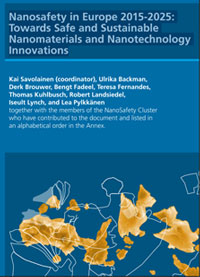| Jun 25, 2013 | |
Nanotechnology safety in Europe 2015-2025 - a research strategy for the European Commission |
|
| (Nanowerk News) The Finnish Insitute of Occupational Health, together with the members of the European Nanosafety Cluster, that is, over a hundred European nanosafety research experts, have produced a research strategy for the European Commission. The strategy outlines the focal points of nanomaterial safety research for the Commission’s 8th framework programme (Horizon 2020). | |
 The document is available as a free download: "Nanosafety in Europe 2015-2025: Towards Safe and Sustainable Nanomaterials and Nanotechnology Innovations". Background Nanotechnology has been identified as one of the key enabling technologies (KET) in Horizon 2020 thus underlining the significance of this field for Europe’s competitiveness and its ability to provide the innovative goods and services essential for meeting global challenges. In particular, nanotechnology offers substantial possibilities for improving the competitive position of the EU and for responding to key societal challenges. Ensuring the safe and sustainable development and application of the nanotechnologies is thus a key objective. The aim of this document (Strategic Research Agenda; SRA) is to introduce a strategic vision for future research on the safe use and safe applications of engineered nanomaterials (ENM). The time horizon for this document is 2015-2025. The SRA has been developed by members of the European NanoSafety Cluster, a forum for ongoing FP6 and FP7 projects covering all aspects of nanosafety. The implementation of the SRA is expected to provide a major step forward in the development of safe and sustainable nanomaterials. |
|
| The goals of this document are to describe the current level of knowledge of the safety of nanomaterials and nanotechnologies, to identify knowledge gaps, and to set out concrete goals for the research on safety of ENM within the foreseeable future. In addition, an overview of the nanosafety landscape is provided. Nanosafety is seen as an integral part of the development of any novel nanotechnology or product; a multi-disciplinary and multi-stakeholder approach is needed to promote a culture of nanosafety in Europe and beyond. | |
| Key challenges today are that available tools for the assessment of the safety of ENM are often inappropriate, or so laborious that adequate safety assessment remains highly problematic. Current resources or test methods are not likely to enable safety assessment of the numerous novel nanomaterials that are emerging at an ever increasing pace. This means that new safety assessment paradigms need to be developed during coming years to solve this problem. At the same time it is important to support regulators and the nanotechnology industry so that prosperity is maintained and current products are made safe for citizens in Europe and elsewhere. This situation calls for rapid identification of research priorities and of a roadmap for nanosafety; we cannot afford to wait. | |
| Several cross-cutting issues that need to be addressed in order to promote growth of the nanotechnology industry are identified in this document. These cross-cutting issues include: 1) the regulatory framework for ENM and nanotechnologies, coupled to the important issue of standardization to promote good practice and to facilitate communication; 2) the innovation/value chain for environmental health and safety and innovation and means to ‘unblock’ the value chain; 3) the development of infrastructures for nanosafety to promote research, education, and innovation; and 4) international collaboration and global dialogue, with a view towards a global research area in nanosafety, along with 5) communication and dissemination of research to key stakeholders beyond the research community, including industry, regulatory bodies, and others. | |
| In addition, the SRA describes the current status and the research needs and priorities for the coming 10 years in four main thematic areas: 1) nanomaterial identification and classification; 2) nanomaterial exposure and transformation; 3) hazard mechanisms related to effects on human health and the environment; and 4) tools for the predictive risk assessment and management including databases and ontologies. | |
| The SRA concludes with a set of research priorities that are required in order to reach the goals of the roadmap. Ultimately, the successful and timely implementation of this roadmap – which is subject to further refinements as new research priorities emerge - will lead to the development of a nanoEHS (Environment, Health and Safety) tool box for exposure assessment, for hazard prediction, and for risk assessment and prediction as well as management that will allow the sustainable implementation of nanotechnologies. As an “enabling technology”, nanotechnology is applied early on and is a key element in the innovation/value chain. There is tremendous potential for nanotechnology to provide answers to societal solutions and it is therefore of critical importance to incorporate nanosafety into the development of novel nanotechnologies and products – safety before design. |
| Source: Finnish Insitute of Occupational Health |
